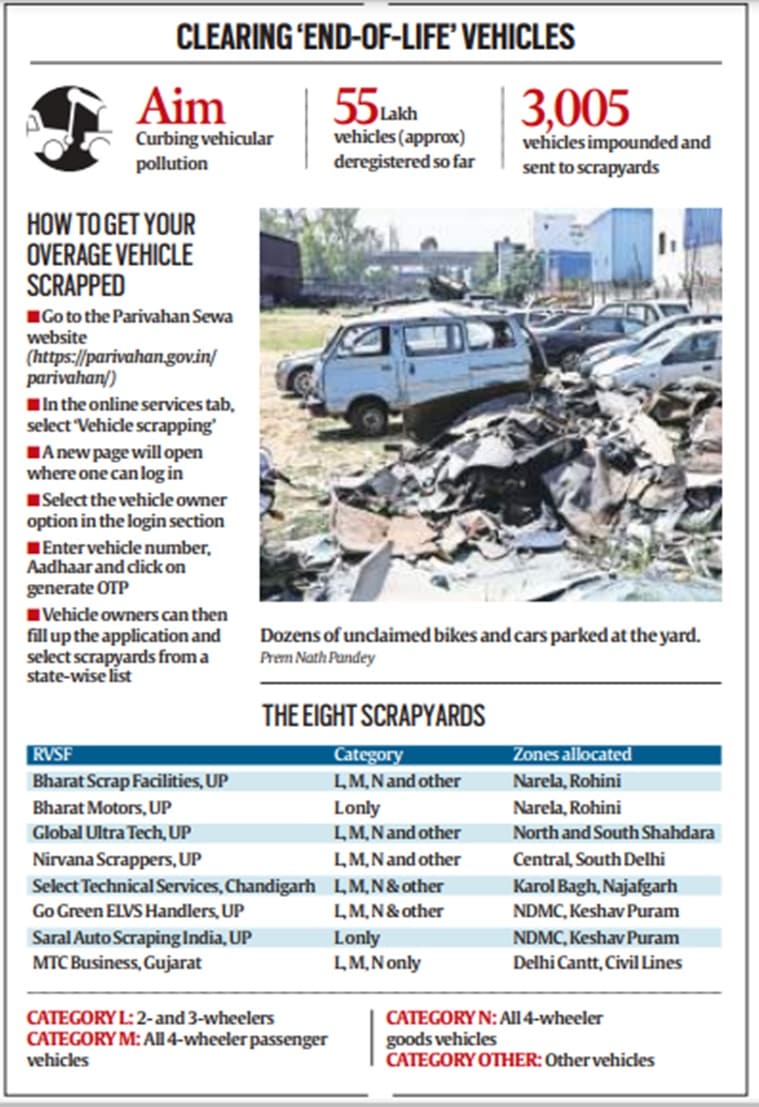End of the road: what happens to overage vehicles picked up in special drive in Delhi
On March 29, the Delhi government’s transport department kicked off its drive to impound overage vehicles. The Indian Express tracks their bumpy journey from road to scrap— amid public outcry and tussles between the bureaucracy and government.
 At the Saral Auto scrapyard in Uttar Pradesh. It picks up vehicles in NDMC and Keshav Puram areas. (Express Photo by Prem Nath Pandey)
At the Saral Auto scrapyard in Uttar Pradesh. It picks up vehicles in NDMC and Keshav Puram areas. (Express Photo by Prem Nath Pandey) Punjabi Bagh resident Naveen Khurana (49) deals in classic and vintage vehicles, that are used as props in movies, and had left one of them — a 96 Mercedes-Benz — at a workshop in West Delhi’s Paschim Puri for servicing. To his utter shock a few days later, he found that it had been picked up on April 26 by the transport department, under its special drive against ‘end-of-life’ vehicles (ELV), and sent to a scrapyard in the NCR.
Khurana claimed, “I have a business in bathroom fittings and also deal in classic and vintage cars. I don’t even drive the Mercedes, I get it repaired every now and then and lease it for shootings that take place in Delhi and neighbouring cities such as Gurgaon, Noida. The vehicle is even transported to the location in a truck. They (enforcement team) did not even inform me, they just pasted the memo at the shop and seized the vehicle from the mechanic. Now, they’re not releasing it.”

When he called the scrapyard, he was told his car would be scrapped and the scrap value would be around Rs 20,000. “The car’s bumper was imported from Germany,” rued Khurana.
Vikram Jeet’s Maruti Esteem, which he parked outside his office at South Delhi’s Anand Niketan, was lifted on April 15 under the same drive and sent to a scrapping unit. The 44-year-old claimed his vehicle was not parked in a public place.
“I received a seizure memo and when I called the scrapyard, they asked me to go to the transport department. My car has crossed the 15-year limit but it was in good shape. I was planning to get it retrofitted into an electric vehicle or get an NOC to sell it in another state. The car also has a VIP number plate which is auctioned for a very high price; it is worth Rs 4-5 lakh. Moreover, the scrap value is just Rs 17,000, less than the market rate,” he said.
He moved court and managed to get a stay. “My car is still at the scrapyard. I will soon move an application to get my car out and retain the VIP number,” he said.
The travails of the two men are a familiar tale for those with petrol or diesel vehicles older than 15 or 10 years (respectively) in the capital. The reason: a ban on all overage petrol and diesel vehicles issued in 2021 by the transport department, in compliance with directions of the Supreme Court and National Green Tribunal, and a drive to impound these.
On March 29, the transport department launched the ‘special drive’ against ELVs across the city and a total of 2,509 vehicles were impounded and sent to scrapyards. It was discontinued briefly before resuming on May 29 and 496 vehicles, including luxury cars, were lifted till Friday.
The department has also said that if any ELV is found parked in a public space or plying on the road, it will be impounded by a police or transport enforcement unit and sent to the scrapyard.
It further issued another order stating that diesel vehicles older than 10 years will automatically be de-registered from January 1, 2022.
So far, the department has deregistered around 55 lakh diesel and petrol vehicles including cars, trucks, bus, auto-rickshaws, two-wheelers.
The drive
Around 10 am, a team of 4-5 enforcement officers began their zone-wise drive. If any overage vehicle was found parked in public places such as colony roads, it issued a seizure memo to the owner if he was home. Else, the memo was pasted on a tree, wall of the house, nearby shop or even an electricity post. To avoid legal hassles, the team photographed and recorded the entire process.
The team then shared the location of the vehicle with the scrapyard, which came with a crane to take it to a nearby designated ground/area. The seizure memo mentions the date, time, the area where the vehicle has been seized from, and the name and address of the authorised Registration and Functions of Vehicle Scrapping Facility (RVSF). “The scrapyard will make the payment of scrapped value directly to the registered owner of the said (seized) vehicles as per Ministry of Steel rules,” said a transport department official.
After 11 pm every day, the seized vehicles are taken to scrap yards.
Under the Centre’s Motor Vehicle (Registration and Functions of Vehicle Scrapping Facility) Rules 2021 — which the transport department has implemented — there are eight registered RVSFs associated with the enforcement team in different MCD zones, which have been allotted licences on the type of vehicles they are allowed to seize.
The RVSFs are located in NCR regions such as Ghaziabad, Noida and other places in UP, Punjab and Gujarat. They can get their licence from any state and it is valid for up to three years.
At the scrapyard
To see where these vehicles are going and how they get scrapped, The Indian Express visited two scrapyards — Saral Auto Scraping India Private Limited in UP’s Morta and Go Green ELV Handlers in Khekra, Baghpat.
The Saral scrapyard picks up vehicles in NDMC and Keshav Puram areas. It is spread across three acres and has an open ground where dozens of unclaimed bikes and cars, including luxury ones and some belonging to the UP government, are parked. It also has two garages — one to store reusable parts such as tyres, headlights, steering wheels, car seats etc, and the second to manually cut the vehicles.
In one corner of the yard is a green crusher, which turns vehicle parts into square-shaped boxes. “We cannot give just the parts to the recycling unit as it is hard to melt. So, the machine makes it easier by crushing them into a small box,” said Khan.
Explaining the scrapping process, Khan said they first wait for calls from people whose vehicles have been impounded and sent to the scrapyard as they don’t have access to their contact numbers.
“As soon as our office opens at 9 am, the phone starts ringing. Mostly, it is owners whose vehicles have been impounded. Over a call, we explain the procedure and ask them for documents — copies of their Aadhaar card, PAN, address proof, vehicle number, account details. We also tell them about the scrap value and that they can check this for themselves on the Ministry of Steel’s website.”
Once they get the owners’ consent, the vehicle is scrapped and the scrap value amount is sent to their account. The RVSFs also submit a certificate of deposit, certificate of vehicle scrapping and proof of payment to vehicle owners.
“We wait for three months, we do not touch the vehicle until the owner gives his assent. After that, if the vehicle owner does not turn up or agree, we scrap it and submit the deposit to the government treasury of the transport department,” said Khan.
Khan said vehicle owners often bargain a lot over scrap value but he has to follow government guidelines. On average, he said the scrap value of a small vehicle like a WagonR is around Rs 15,000-20,000, while a luxury car’s value goes up to Rs 60,000-70,000.
He added that several checks are in place to ensure everything is above board: “We make videos of the vehicles being crushed to send to the owners; CCTVs are installed in the yard to maintain a record of all vehicles; we also check if any vehicle has been involved in any kind of criminal activity or thefts.”
Outrage and a tussle
Angered by the drive, over 20 vehicle owners have moved court against the transport department, alleging it forcefully took their vehicle without even informing them. “My vehicle was parked outside my house and I wanted to get it retrofitted into an electric vehicle once the government comes out with the kits. Why does the transport not clarify this?” said Vikramjeet.
The Aam Aadmi Sena, an outfit that was formed after breaking away from the Aam Aadmi Party, has also alleged that vehicles are being lifted from houses of people and scrapped illegally. “The Delhi government and scrap mafia are flouting the scrapping policy. The enforcement team intimidates owners and takes their vehicles,” alleged Prabhat Kumar, national president.
The drive, meanwhile, has also led to a tussle between the transport department and its minister.
Following complaints from vehicle owners, Transport Minister Kailash Gahlot put a stop to the drive on May 3. The department, however, took the matter to Chief Secretary Naresh Kumar on May 10 and wrote a letter to the Commission for Air Quality Management (CAQM), the apex air pollution monitoring body, seeking clarifications.
The CAQM, on May 25, responded to the transport department and asked it to initiate “appropriate action against all such end-of-life/ overage vehicles either plying on roads or parked in public places in the NCT of Delhi, in pursuance of NGT’s and Supreme Court’s orders”.
The commission’s order defined ELVs as all those that don’t have a valid registration; are declared unfit through automated fitness centres; whose registrations have been cancelled under Chapter IV of the Act or due to a court order; or are self-declared by legitimate registered owners as waste vehicles.
It also said “there is absolute clarity as to how to deal with end-of-life vehicles”.
Following the order, special commissioner (transport) Shazad Alam continued the drive. According to senior officials, this prompted Gahlot to write a letter to the department saying the “government will not provide assistance and support”.
“This happened after the minister received several complaints and cases in court increased. The government has said the officials will have to manage their own cases,” said a senior official.
Asked about complaints from people of their vehicles being lifted forcibly, Alam said, “The drive is being carried out as per rules and guidelines. The CAQM clearly says if a vehicle has crossed its life and is de-registered by the government, it can neither ply nor be parked in a public place. Even if a vehicle is outside a house, if it’s a public place then the department has the right to impound it. We don’t take vehicles that are inside a plot or gated colony.”
Alam also said people are making excuses, like getting an NOC, to cause delays: “The NOC is given within 2-3 days,” he said, adding, “People can get their vehicles scrapped from any registered RVSF, situated in the NCR.”
When asked about retrofitment of vehicles, he said, “We are working on the project. But it is a very expensive process and many are not interested in getting their vehicles retrofitted.”







